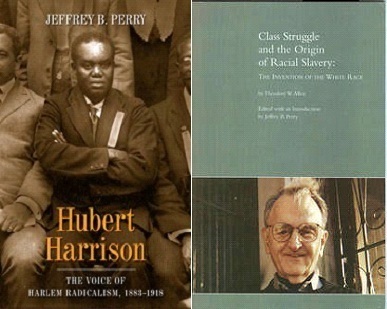As the economic situation worsens people are encouraged to read “The Developing Conjuncture and Some Insights From Hubert Harrison and Theodore W. Allen on the Centrality of the Fight Against White Supremacy” at the TOP LEFT HERE or at Cultural Logic HERE
Harrison and Allen were two of the twentieth century’s most important thinkers on issues of race and class and they have much to offer for struggles ahead.
“Overall, the facts of the current conjuncture indicate that millions of poor and working people are suffering under U.S. capitalism, that millions are suffering under the white supremacist shaping of this system, that these conditions are inter-related, and that these conditions are worsening.”
Table of Contents
Epigraph
Introduction
Hubert Harrison
Theodore W. Allen
Harrison and Allen and the Centrality of the Struggle Against White-Supremacy
Some Class and Racial Aspects of The Conjuncture
Deepening Economic Crisis
U.S. Workers Faring Badly
White Supremacist Shaping
Wisconsin
Millions are Suffering and Conditions are Worsening
Insights from Hubert Harrison
Arrival in America, Contrast with St. Croix
Socialist Party Writings
“Southernism or Socialism – which?”
The Socialist Party Puts [the “White”] Race First and Class After
Class Consciousness, White Supremacy, and the "Duty to Champion the Cause of the Negro"
On “The Touchstone” and the Two-Fold Character of Democracy in America
Concentrated Race-Conscious Work in the Black Community
Capitalist Imperialism and the Need to Break Down Exclusion Walls of White Workers
The International Colored Unity League
Struggle Against White Supremacy is Central
Insights from Theodore W. Allen
Early Research and Writings and Pioneering Use of “White Skin Privilege” Concept
White Blindspot
Why No Socialism? . . . and The Main Retardant to Working Class Consciousness
The Role of White Supremacy in Three Previous Crises
The Great Depression . . . and the White Supremacist Response
Response to Four Arguments Against and Five “Artful Dodges”
Early 1970s Writings and Strategy
“The Invention of the White Race”
Other Important Contributions in Writings on the Colonial Period
Inventing the “White Race” and Fixing “a perpetual Brand upon Free Negros”
Political Economic Aspects of the Invention of the “White Race”
Racial Oppression and National Oppression
“Racial Slavery” and “Slavery”
Male Supremacy, Gender Oppression, and Laws Affecting the Family
Slavery as Capitalism, Slaveholders as Capitalists, Enslaved as Proletarians
Class-Conscious, Anti-White Supremacist Counter Narrative – Comments on Jordan and Morgan
Not Simply a Social Construct, But a Ruling Class Social Control Formation . . . and Comments on Roediger
The “White Race” and “White Race” Privilege
On the Bifurcation of “Labor History” and “Black History” and on the “National Question”
Later Writings . . . “Toward a Revolution in Labor History”
Strategy
The Struggle Ahead
Addendum [re “Daedalus”]
Read More
Harrison and Allen were two of the twentieth century’s most important thinkers on issues of race and class and they have much to offer for struggles ahead.
“Overall, the facts of the current conjuncture indicate that millions of poor and working people are suffering under U.S. capitalism, that millions are suffering under the white supremacist shaping of this system, that these conditions are inter-related, and that these conditions are worsening.”
Table of Contents
Epigraph
Introduction
Hubert Harrison
Theodore W. Allen
Harrison and Allen and the Centrality of the Struggle Against White-Supremacy
Some Class and Racial Aspects of The Conjuncture
Deepening Economic Crisis
U.S. Workers Faring Badly
White Supremacist Shaping
Wisconsin
Millions are Suffering and Conditions are Worsening
Insights from Hubert Harrison
Arrival in America, Contrast with St. Croix
Socialist Party Writings
“Southernism or Socialism – which?”
The Socialist Party Puts [the “White”] Race First and Class After
Class Consciousness, White Supremacy, and the "Duty to Champion the Cause of the Negro"
On “The Touchstone” and the Two-Fold Character of Democracy in America
Concentrated Race-Conscious Work in the Black Community
Capitalist Imperialism and the Need to Break Down Exclusion Walls of White Workers
The International Colored Unity League
Struggle Against White Supremacy is Central
Insights from Theodore W. Allen
Early Research and Writings and Pioneering Use of “White Skin Privilege” Concept
White Blindspot
Why No Socialism? . . . and The Main Retardant to Working Class Consciousness
The Role of White Supremacy in Three Previous Crises
The Great Depression . . . and the White Supremacist Response
Response to Four Arguments Against and Five “Artful Dodges”
Early 1970s Writings and Strategy
“The Invention of the White Race”
Other Important Contributions in Writings on the Colonial Period
Inventing the “White Race” and Fixing “a perpetual Brand upon Free Negros”
Political Economic Aspects of the Invention of the “White Race”
Racial Oppression and National Oppression
“Racial Slavery” and “Slavery”
Male Supremacy, Gender Oppression, and Laws Affecting the Family
Slavery as Capitalism, Slaveholders as Capitalists, Enslaved as Proletarians
Class-Conscious, Anti-White Supremacist Counter Narrative – Comments on Jordan and Morgan
Not Simply a Social Construct, But a Ruling Class Social Control Formation . . . and Comments on Roediger
The “White Race” and “White Race” Privilege
On the Bifurcation of “Labor History” and “Black History” and on the “National Question”
Later Writings . . . “Toward a Revolution in Labor History”
Strategy
The Struggle Ahead
Addendum [re “Daedalus”]
Read More
